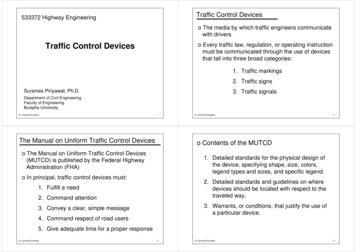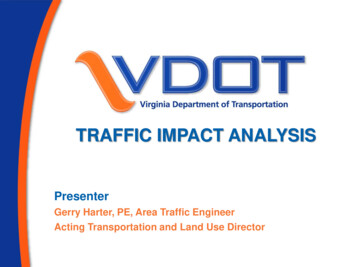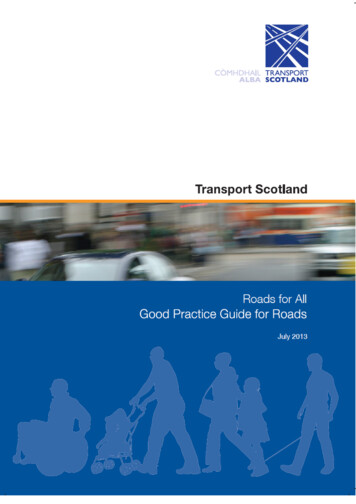
Transcription
gTrafficManagement forWorks on RoadsCODE OF PRACTICEMAY 2022
TRAFFIC MANAGEMENT FOR WORKS ON ROADSCODE OF PRACTICEAll printed copies are uncontrolledMain Roads Western AustraliaPlanning and Technical Services DirectorateRoad Safety BranchMay 2022
This document was originally endorsed by the Traffic Management for Works on RoadsAdvisory Group on 3 March 2004. Revisions are endorsed by the Advisory Group andapproved by Main Roads Executive Director Planning and Technical Services. TheAdvisory Group consists of members from Main Roads Western Australia (Main Roads),Australian Institute of Traffic Planning and Management (WA division) (AITPM), CivilContractors Federation (CCF), Institute of Public Works Engineering Australia (WAdivision) (IPWEA), Traffic Management Association of WA (TMAWA), WA LocalGovernment Association (WALGA), WA Police (WAPOL), Traffic Management TrainingProviders, Utility Providers and Engineers Australia (WA division).A specialist Technical Committee comprising members from Main Roads, IPWEA (WAdivision) and WALGA has provided technical advice in regard to various sections of thisdocument.Amendments to this document may be made from time to time reflecting the changes intechnology, standards or legislation as well as the feedback from the industry, subject toendorsement by the Advisory Group. Users of this document are warned to make surethat they are using the current document which is available on Main Roads website atwww.mainroads.wa.gov.au; go to ‘Technical & Commercial’ ‘Working on Roads’
AMENDMENT / REVISION STATUS RECORDDateSectionAmendment / Revision DescriptionMay 2022WholedocumentAdoption of WHS lawsWholedocumentTable numbers modified (12-17)Section 6.5.2Figure 1 notes modified; table 5 footnotes removedSection 6.8.2Clarification added for determining queue lengthSection 6.8.3Mandatory use of PTCDs on MRWA roads as of 1 July2022Section 6.8.6New section – Shuttle FlowSection 6.13Mandatory use of shadow vehicles addedSection 6.14New section – TTM Implementation, Operation andRemovalSection 7.3Main Roads to mandate Speed feedback signs in early2023Appendix 1Addition of ‘State Road’ definitionAppendix 4Distribution list updatedAppendix 5Addition of blank yellow panelsSection 1.3.1Adoption of AGTTM version 1.1.Section 2Clarification added for approval timesSection 2.1.1Reference to Smart Freeway TGSSection 2.1.2Clarification - Traffic Management RegistrationScheme required for lane closure or speed limitimplementationSection 4.2.3Reference to ‘80km/h’ removed from third dot point initem iiSection 4.2.5New section - Traffic Management Implementation andRemovalSection 4.3Clarification – pre-treatment risk rating for works nearlive trafficDecember2021
Section 4.4.1Clarification - Dot point 4 ‘children’s crossing’ with noTraffic Warden changed to ‘pedestrian crossing’Section 6.1Signs to be manufactured in accordance with MainRoads SpecificationsSection 6.1.9New section – Sign SpacingSection 6.2.2Reference to AS1742.3 addedSection 6.2.3MMS to be manufactured in accordance with MainRoads SpecificationsSection 6.5Note added to table 5 for approach speeds of 70 km/hSection 6.8.1Modification of centreline conesSection 6.8.2Clarification - stopping distance may exceed table 10.Addition of Queued Traffic signsSection 6.8.3PTCD requirements updatedSection 6.8.5New section - Stop-slow batsSection 6.9TMA guideline name change, document updatedSection 6.10Warning lamp requirements addedSection 6.11Removal of traffic volume departures now included inAGTTMSection 6.12Mobile work departures added for distance of shadowvehicle and advance warning vehicles.Section 6.13New section - Shadow VehiclesSection 7.2Reference to AS 5156 addedSection 7.3Speed feedback sign requirements addedSection 7.4New section – Traffic Monitoring and SurveillanceAppendix 1Addition of ‘Must’ definitionAppendix 5MMS-ADV-22 not to be used in conjunction with aregulatory signMMS-POS-8 should be used with ON SIDE ROADMMS-REG-2 may be used on mobile convoysNew signs: Advance Warning Series: MMS-ADV-90 toMMS-ADV-101Event Series: MMS-EVE-10Regulatory Series: MMS-REG-14
February2021WholedocumentAdoption of the Austroads Guide to Temporary TrafficManagementWholedocumentReferences to AS1742.3-2009 changed to AS1742.32019.Section 1Scope and Introduction combined.Addition of Austroads Safety at Road Worksitesproject.Sections 2, 3and 4Sections moved forward (due to Scope andIntroduction combined)Section 2.1.2Traffic management company registration scheme onsite personnel requirement added.Section 4.4Children’s Crossings and School Zones and RailwayCrossings (Including Crossings without FlashingSignals) sub-sections relocated to 4.4.1 ConsultationSection 5Sections 5.5 Traffic Management Records and 5.7Reviewing, Auditing and Approving TrafficManagement combined and renamed Review,Inspection, Road Safety Audit and OperationSection 6Due to updates to AS1742.3 and AGTTM the followingsub sections removed:Dimension DSigns for Managing PedestriansGuidelines for use of MMSOffset Speed Zones on Undivided roadsMobile Temporary Speed ZonesExcavations and Other hazardsOverhead Works on or near RoadsPedestrian Protection in Contra-Flow SituationsWorks on Residential Access RoadsFatality or Serious Injury at WorksiteSection 6.1.7New section – Repeater Speed Restriction SignsSection 6.3Additional guidance for securing signs and devicesSection 6.8New requirements for where traffic control is notpermittedRequirements for use of PTCDsSection 6.10Recommendation for size of Illuminated FlashingArrow Sign added
Section 8Sub-sections rearrangedNew accreditation – BWTM non-practitionerRemoval of Provisional AccreditationProvisional accreditation removedJuly 2020May 2020January2020Appendix 1Removal of definitions within AGTTM Part 1Appendix 4Notification of Roadworks Form updated – additionalHVS requirementsAppendix 5New signs: MMS-ADV-85, MMS-ADV-85, MMS-ADV86, MMS-ADV-87, MMS-ADV-88, MMS-ADV-89, MMSREG-8, MMS-REG-9, MMS-REG-10, MMS-REG-11,MMS-REG-12, MMS-REG-13Appendix 4Main Roads WA regional contacts updatedNotification of Roadworks Form Distribution ListupdatedAppendix 5MMS-ADV-83 and MMS-ADV-84 signs addedSection 3.3;4.5; 5.2.3;and 6.8.1All traffic control procedures at permanent trafficsignals relocated to the Temporary TrafficManagement: Traffic Signal Approval PolicySection 9.1Adoption of the AGTTM in Western Australiapostponed to February 2021.Section 3.1.1Traffic Management at Roadworks on State RoadsPolicy and Application Guidelines updatedSection 3.1.3New Section – Works on MRWA Roads in theMetropolitan AreaSection 5.2.2New section - Generic TMPs; Generic TMP Checklistupdated; TGS selection process addedSection 5.2.3RTM site visit exception addedSection 5.4Section renamed Consultation, Communication andNotifications of Roadworks; requirements added forTransperth approval; amendments to Notification ofApproved Roadworks amendedSection 5.5Requirement for Daily Diary to be based on template;clarification to record implemented TGS.Section 6.3.4Additional requirement added for using core flute MMSSection 6.5.4Requirements updated for Delineation of TemporaryRoad Safety Barriers
Sep2018Section 6.8.2Railway Crossing requirements updatedSection 6.13New section - Traffic Control; Avoiding End of QueueCollisions requirements addedSection 6.15Securing signs section relocatedSection 6.16Covering Speed Limit Road Marking relocated andrenamed to Covering Regulatory Road MarkingSection 7.6New section – Speed Feedback SignsSection 8.1Clarification – Traffic Controller tasks include operatingportable traffic control devicesSection 8.5AWTM accreditation – removed RIIWHS201D andRIIGOV401DSection 8.7RTM pre-requisites amendedSection 9New section – Austroads Safety at Road WorksitesSection 3.1Additional text added regarding planning works.Section 5.6Table 4.9 of AS1742.3 added to traffic flow variations.Section 6.8.1Reference to Traffic Operations Centre (TOC) replacedwith Road Network Operations Centre (RNOC).Spelling error amended.Appendix 4TOC replaced with RNOC and email address updated.Appendix 5Signs MMS-ADV-4, MMS-ADV-5, MMS-DIV-6, or MMSDIV-7 not to be used in conjunction with a regulatorysign. Text added for use of MMS-REG-4.MMS example configurations amended.
ForewordWestern Australia has over 170 000 kilometres of roads, which periodically require reconstruction, maintenance or work on services within their road reserve. With currenteconomic recovery efforts, in response to the COVID-19 pandemic being focused onprovision of public infrastructure, more than 8 billion of funding has been allocated totransport projects. This will significantly increase the amount of works being conductedon Western Australian roads. If not managed well, these tasks have the potential tocreate hazardous situations for both road workers and users that may produce serious oreven fatal consequences.Main Roads Western Australia has adopted the Safe System approach to managing theroad network and the Traffic Management for Works on Roads Code of Practice utilisesthese principles. This Code provides mechanisms to protect all road users (includingroad workers), acknowledging that people are fallible and have limited ability to tolerateimpact forces.I have authority under Regulation 297 of the Road Traffic Code 2000, to erect, establishor display, alter or take down any road sign or traffic control signal. With this comes aduty of care to facilitate the safe and appropriate use of road signs and devices. Theserequirements have been developed in conjunction with key stakeholders in recognition ofthis obligation.The requirements promote safe and consistent traffic management practice at work siteson roads in accordance with state legislation and national standards. They requiregeneral compliance with the Austroads Guide to Temporary Traffic Management(AGTTM) and Australian Standard 1742.3 - 2019, with details of additional requirementsnecessary to meet Western Australian requirements and advise of departures to therequirements of the AGTTM and Australian Standard that I am prepared to allow onWestern Australian roads. The requirements also outline the competency requirementsfor personnel responsible for managing traffic on work sites and the need to hold aqualification relevant to the specific task in traffic management.This document, initially released in March 2004, has been prepared following extensiveconsultation with local government, industry and other stakeholders through AdvisoryGroup meetings, Technical Committee meetings, a technical workshop and otherforums.I encourage all persons involved in managing traffic at work sites on roads to fullyfamiliarise themselves with these requirements, to apply them with due consideration tothe situations that present to them and to carefully comply with the mandatoryrequirements. This will result in safer work sites for yourselves, your fellow workers andall road users.Peter WoronzowCOMMISSIONER OF MAIN ROADS
Contents1.INTRODUCTION AND SCOPE1.11.2INTRODUCTIONSCOPE12121.3AUSTROADS SAFETY AT ROAD WORKSITES131.3.11.3.22.2.1.12.1.22.1.34.Austroads Guide to Temporary Traffic ManagementRoad Categories and TrainingAPPROVAL TO WORK WITHIN ROAD RESERVES2.13.ROADS FOR WHICH MAIN ROADS IS RESPONSIBLEMain Roads Policy for Works on High Volume RoadsTraffic Management Company Registration SchemeWorks on Main Roads Roads in the Metropolitan Area1616171718182.318WORKS AFFECTING TRAFFIC SIGNAL OPERATIONAUTHORITY TO ERECT TRAFFIC CONTROL DEVICES193.1MAIN ROADS193.2MAIN ROADS AGENTS193.3AUTHORISED BODIES AND THEIR AGENTS193.43.5OTHERS NOT PARTY TO AN INSTRUMENT OF AUTHORISATIONAUTHORISING TRAFFIC MANAGEMENT PLANS1920PLANNING THE WORKS214.1DUTY OF CARE214.2TRAFFIC MANAGEMENT PLANS214.3GeneralGeneric TMPsTraffic Management Plans Involving ‘Complex Traffic Arrangements’Temporary Road Safety Barrier Detail in TMPsRISK MANAGEMENT4.4CONSULTATION, COMMUNICATION AND NOTIFICATION OFROADWORKS4.4.14.4.24.5ConsultationNotification of Approved RoadworksVARIATION TO THE CODE, AGTTM AND STANDARDSREVIEW, INSPECTION, ROAD SAFETY AUDIT AND OPERATION5.15.1.15.1.25.1.35.1.45.26.13152.2ROADS FOR WHICH LOCAL GOVERNMENT OR OTHERS ARERESPONSIBLE4.2.14.2.24.2.34.2.45.12REVIEW, INSPECTION AND ROAD SAFETY AUDIT2122232525262729303131AuditsSuitability Reviews and Compliance Safety InspectionsSuitability CheckReview and Audit Checklists31313232TRAFFIC MANAGEMENT OPERATION AND RECORDS32DEPARTURES FROM DESIGN REQUIRMENTS IN AS1742.3 AND AGTTM33
6.5.26.66.6.16.6.28.GeneralREDUCE SPEED SignsNEW WORK NO LINES MARKED SigningROAD INSPECTION SignCYCLIST DISMOUNT SignPedestrian Warning Signs for MotoristsRepeater Speed Restriction SignsROAD CLOSED and FOOTPATH CLOSED SignsSign SpacingGUIDELINES FOR MULTI-MESSAGE SIGNSIntroductionFrames for Multi-Message SignsSubstrates for Multi-Message SignsSECURING SIGNS AND DEVICESSecuring SignsSecuring Cones and BollardsCOVERING EXISTING SIGNAGE AND ROAD MARKINGExisting SignsCovering Regulatory Road MarkingSPEED LIMIT ZONESApproval of Temporary Speed Limit SignsSetting out Temporary Speed Zones (Buffer Zones)TEMPORARY ROAD SAFETY BARRIER SYSTEMSDelineation of Temporary Road Safety BarriersBarrier Edge 3939394242436.7MINIMUM LANE WIDTHS446.8TRAFFIC CONTROL446.8.16.8.26.8.36.8.46.8.56.8.67.TEMPORARY SIGNAGEAdvanced Warning SignsAvoiding End of Queue CollisionsPortable Traffic Control DevicesTraffic ControllersStop-Slow BatsShuttle flow4446495151526.9TRUCK MOUNTED ATTENUATORS536.10ILLUMINATED FLASHING ARROW SIGN536.11TRAFFIC VOLUME536.126.13MOBILE WORKSSHADOW VEHICLE54556.14TTM IMPLEMENTATION, OPERATION AND REMOVAL58BEST PRACTICE607.1INNOVATIVE TRAFFIC CONTROL DEVICES607.27.3ELECTRONIC SPEED LIMIT SIGNSSPEED FEEDBACK SIGNS60617.4TRAFFIC MONITORING AND SURVEILLANCE61ACCREDITATION REQUIREMENTS628.1GENERAL628.28.3TRAFFIC CONTROLLER ACCREDITATIONBASIC WORKSITE TRAFFIC MANAGEMENT ACCREDITATION6364
8.3.1Basic Worksite Traffic Management - Non - Practitioner648.4WORKSITE TRAFFIC MANAGEMENT ACCREDITATION658.5ADVANCED WORKSITE TRAFFIC MANAGEMENT ACCREDITATION658.6ROADWORKS TRAFFIC MANAGERS ACCREDITATION668.7OPERATE TRUCK MOUNTED ATTENUATOR678.8PROOF OF CERTIFICATION678.9ISSUE OF CERTIFICATION AND RE-ACCREDITATION679.10.FURTHER INFORMATIONREFERENCES6868Appendix 1:DefinitionsiAppendix 2:Traffic Risk ClassificationivAppendix 3:Typical Instrument of Authorisation for Local GovernmentviiAppendix 4:Sample ‘Notification of Roadworks’ FormAppendix 5:Multi-Message Sign Inventory and Application Schedulexxiii
1.1.1INTRODUCTION AND SCOPEINTRODUCTIONThis Code of Practice (herein after referred to as the ‘Code’) describes the Main Roads WesternAustralia’s (Main Roads) requirements for managing traffic at work sites on roads. It requirestraffic management for works on roads to be based on the Austroads Guide to Temporary TrafficManagement (AGTTM) and AS 1742.3–2019, unless otherwise specified by a requirement inthis Code. In the event that there is a conflict between this Code and AGTTM or AS 1742.3 –2019, the Code shall take precedence.The purpose of this Code is to specify any variations or additional requirements to AGTTM andAS 1742.3 – 2019 which are required at works on roads in Western Australia.The prescribed practices are the minimum requirements, on which the Traffic ManagementPlans (TMPs) for all Western Australian roads shall be based. Main Roads recognises thatsituations sometimes arise where application of these requirements is not appropriate and thatvariation to these requirements will be necessary. When it becomes apparent that deviation isnecessary from the requirements of this Code, persons arranging the works should carefullyconsider all possible options, using common sense and judgment based on ‘risk management’carried out in accordance with sections 4.3 and 4.5. Further, they shall ensure that theiractions are consistent with related legislation.See AGTTM Part 1 for more details on Temporary Traffic Management (TTM) purpose,philosophy and principles.Practitioners should be aware of the document titled Traffic Management for Events Code ofPractice that has been placed on Main Roads’ website - see ‘Technical and Commercial’ ‘Working on roads’. This document has been designed to complement the Traffic Managementfor Works on Roads Code of Practice in respect to the various traffic management issues thatare common to works on roads and to events, particularly in respect to the design andimplementation of Traffic Management Plans.1.2SCOPEThis Code applies to all work conducted within all road reserves throughout Western Australiaand the planning of any proposed works.Where it appears in the Code the term ‘work’ refers to: construction and maintenance work in work sites wholly or partly within the roadreserve boundaries and shall apply in any situation where traffic control devices areused to warn, instruct and guide road users in the safe negotiation of work sites onroads including unsealed roads together with footpaths, shared paths, and bicyclepaths adjacent to the roadway; or any other works which cause interference or obstruction to the normal use of a road byany road user.This Code is applicable to traffic management for road and bridge construction andmaintenance sites, as well as works associated with other public utilities and services.MAIN ROADS Western AustraliaPage 12
1.3AUSTROADS SAFETY AT ROAD WORKSITES1.3.1Austroads Guide to Temporary Traffic ManagementThe 2019 update of AS1742.3 by Standards Australia has resulted in the removal of contentfrom the existing standard (2009) that has been determined to be guidance material, which isnot appropriate to locate within an Australian Standard. This guidance material has now beensubstantially transferred into the Austroads Guide to Temporary Traffic Management (AGTTM)with an expansion to the guidance material based on information from Austroads memberorganisations.The Guide to Temporary Traffic Management (AGTTM) is a set of comprehensive Austroadspublications developed to provide a best practice reference for the development of safe, costeffective and efficient Temporary Traffic Management (TTM) solutions for Australia and NewZealand. Comprised of 10 parts, AGTTM is now freely available on the Austroads website(www.austroads.com.au go to ‘Transport Network Operations’ ‘Temporary TrafficManagement’).AGTTM version 1.1 has now been adopted in Western Australia. Note: no changes weremade to AGTTM Part 8.MAIN ROADS Western AustraliaPage 13
The table below outlines the WA adoption of AGTTM, sections refer to sections of this Code.Table 1 – AGTTM AdoptionPart Name1Planning 2DesignField3Traffic ManagementPlanningStatic Work Sites4Mobile Works5Short Term Low ImpactWorksField Staff –Implementation andOperationTraffic ControllersInstructionsProcesses andProcedures67SupportIntroduction and General89Sample Layouts10Supporting Guidance(Risk Management,Surveillance, Events)WA Adoption and Code of PracticeReferenceAdoptedAdopted, refer to section 4* for additional WATraffic Management Planning requirementsAdopted, refer to section 6* for WAdepartures and additional requirementsAdopted, refer to section 6.12 for WAdeparturesAdoptedAdopted, refer to section 5.2* for additionalrequirementsAdopted, refer to section 6.8* for departuresand additional traffic controller requirements Road Categories for TTM – seesection 1.3.2* Process for TGS Selection –incorporated in section 4.2.2* TTM approvals – refer to section 2* Powers and Responsibilities –adopted with additional WA specificinformation in section 2* and 3* TTM Training Framework – seesection 1.3.2* Standard Forms – WA forms on theMain Roads website have beenretainedAdopted, refer to section 6* for WAdepartures for TGS design Risk Management for TTM – seesection 4.3* Review, Inspection and Road SafetyAudit – see section 5* Events on Roads – refer to the TrafficManagement for Events Code ofPractice Emergency Works - adopted*All references refer to sections of this Code.MAIN ROADS Western AustraliaPage 14
1.3.2 Road Categories and TrainingAustroads TTM Road CategoriesA road categorisation system has been adopted in the AGTTM based on the New Zealandroad levels. While all works on roads are considered high risk, the categorisation into threecategories allows design practices and training to be tailored to the different risk levels at eachcategory.See AGTTM Part 8 for more details.The WA road network is yet to be categorised, this will be done in consultation with RoadAuthorities prior to the tiered approach to training and company prequalification being rolledout. Unless this Code states otherwise any recommendations or requirements within AGTTMbased on road categories should be considered as a guide.Austroads National Training Framework for TTMThe national training framework is not currently adopted in WA, refer to section 8 for WAtraining and accreditation requirements.Details of the National Austroads Training Framework are within AGTTM Part 8Austroads will be developing the entire training package, this has been delayed and isscheduled to be completed in the second quarter of 2022. Following project completion therewill be an 18-month transition period before the framework is adopted in WA. Those withinindustry will then be trained under the tiered approach over the following 3 years.MAIN ROADS Western AustraliaPage 15
2.APPROVAL TO WORK WITHIN ROAD RESERVESPrior to commencing works, approval shall be obtained from the agency responsible for thecare, control and management of the relevant roads. Care should also be taken to ensure thatall other required authorisations are obtained prior to the commencement of works. Thesemight include agreement to any variations to the application of this Code of Practice and/orAGTTM / Australian Standards, as well as any development, heritage, environmental, andcultural clearances. Lengthy delays may be experienced if all necessary approvals are notobtained, increasing the risk of undesired traffic incidents.In addition to obtaining approval to work within the road reserve from the relevant RoadAuthority, other agencies such as emergency services, Police, public transport etc. in the areamay need to be notified in advance of the impending works as detailed in section 4.4.All approvals to conduct works on roads issued by Main Roads, local governments or otherAuthorities responsible for roads, shall be suitably noted on the Traffic Management Plan. Amandatory condition requiring traffic management to be carried out in accordance with therequirements of this Code, subject to any agreed variations, shall be included with theapproval.Approved implementation times for Traffic Management Plans and/or Traffic GuidanceSchemes are generally based on traffic capacity. Therefore, unless otherwise stated, nodevices are permitted to close traffic lanes prior to the approved start time and all lanes mustbe reopened to traffic at or prior to the approved finish time.2.1ROADS FOR WHICH MAIN ROADS IS RESPONSIBLEThe Commissioner of Main Roads (CMR) is responsible for the care, control and managementof the land over which any declared ‘highway’ or ‘main road’ exists. Any party intending toconduct work on any ‘highway’ or ‘main road’ reserve shall obtain prior approval from MainRoads.Main Roads has developed comprehensive guidelines and an application kit for thoseintending to undertake work within any ‘highway’ or ‘main road’ reserve in regard to ‘complexworks’, ‘low complexity works’ or ‘utility service works’. These guidelines including contactdetails and the application kit are available on the Main Roads website atwww.mainroads.wa.gov.au; go to ‘Technical and Commercial’ ‘Working on Roads’ ‘ThirdParty Works’.To facilitate prompt approval of applications to work on roads, persons arranging works shouldcontact the relevant Main Roads Regional Office at an early stage to obtain traffic information,the level of service required on the road during the works and details of any otherrequirements that need to be considered whilst preparing their Traffic Management Plans(TMPs).Typically, the proposed works and staging should be determined and approved in principleprior to any TMP being produced. Once in principle approval for the works has been obtained,the TMP designer should gain a comprehensive understanding of the project staging and thenan appropriate TMP can be produced. The TMP should be reviewed by the construction /project manager for suitability prior to being submitted to Main Roads to review and authorise.Depending on the complexity of the project, the time allowed for Main Roads to review shouldbe approximately 15 working days. For works at traffic signals refer to section 2.3.Further information on preparing TMPs is provided in section 4.2.MAIN ROADS Western AustraliaPage 16
Main Roads requires submission of a TMP with all applications to work within its roadreserves. TMPs for the metropolitan area shall be sent to enquiries@mainroads.wa.gov.au. Ifthe works are occurring outside the metropolitan area TMPs shall be submitted to the relevantregional office using the generic email address in Appendix 4.Main Roads will, as it considers necessary, conduct audits of TMPs and refer those that do notcomply with the requirements of this Code, back to the proponent for submission of anacceptable TMP prior to allowing commencement of works.Any organisations with statutory authority to enter Main Roads road reserves in emergencysituations shall advise the Main Roads Customer Information Centre (Ph. 138 138) of theirwork either prior to, or as soon as possible after commencing any emergency service.2.1.1Main Roads Policy for Works on High Volume RoadsMain Roads requires roadworks on its high volume roads to be managed with dueconsideration to traffic efficiency. A policy has been established which puts in place elevatedstandards of traffic management on high volume roads. This Policy and Application Guidelineis titled Traffic Management at Roadworks on State Roads. The policy can be found on MainRoads’ website www.mainroads.wa.gov.au go to ‘Technical and Commercial’ ‘TechnicalLibrary’ ‘Road and Traffic Engineering’ ‘Traffic Management’ ‘Temporary TrafficManagement’The policy sets controls on speed limits, lane closures, merges, emergency lanes, SmartFreeways, worksite access and work times for planned maintenance works. Further advice,tools and recommendations are provided, such as real time traffic monitoring and a congestioncalculator for traffic management planners.Note, Traffic Guidance Schemes and a TMP template has been developed by Main RoadsRoad Planned Interventions (RPI) section for works on Smart Freeways. Contact RPI, viaemail enquiries@mainroads.wa.gov.au or phone 138 138, for any planned works on anysections of the Smart Freeways.2.1.2Traffic Management Company Registration SchemeThe Traffic Management Company Registration Scheme applies to all parties, including localgovernments and Authorised Bodies that implement lane / road closure or speed restriction onState roads. This applies to all State roads across Western Australia. The guidelines includingcontact details and the application kit are available on Main Roads website atwww.mainroads.wa.gov.au ; go to ‘Technical and Commercial’ ‘Working on roads’ ‘TrafficManagement Company Registration Scheme’.Traffic management sites involving ‘complex traffic arrangements’ on Main Roads controlledroads, shall have at least one person with either Worksite Traffic Management or AdvancedWorksite Traffic Management accreditation on-site at all times when road workers are present.Refer to the Austroads website for details on the Austroads Traffic ManagementPrequalification Scheme. Go to www.austroads.com.au ‘Network and Freight’ ‘TemporaryTraffic Management.’ When available, details on the Main Roads adoption and transition willbe provided on the Traffic Management Registration page of the Main Roads website.MAIN ROADS Western AustraliaPage 17
2.1.3Works on Main Roads Roads in the Metropolitan AreaImplementing approved traffic management on the Main Roads road network can often causecongestion that may be flagged by the Road Network Operations Centre (RNOC) as anincident.To avoid any confusion with RNOC, and potential delays to works, it is recommended thatimmediately prior to implementing approved traffic management on Main Roads controlledroads in the metropolitan area, the traffic management personnel onsite contact the MainRoads Road Network Operations Centre (RNOC) on 138 111.2.2ROADS FOR WHICH LOCAL GOVERNMENT OR OTHERS ARE RESPONSIBLEAny party including utility service providers who are Authorised Bodies intending to conductworks on a road reserve that is not a declared ‘highway’ or ‘main road’, shall prior tocommencing the works, contact the relevant local government or the other Authority that isresponsible for the care, control and management of the road to confirm their requirements.Table 2 - Where to obtain approval to work in road reservesLocationContactMain Roads reserve in Perth Metropolitan Regionenquiries@mainroads.wa.gov.auMain Roads reserve outside Perth MetropolitanRegionThe relevant Main RoadsRegional Office - see Appendix 4Local government road reserveThe relevant local governmentOther road reservesThe Authority responsible for theroad2.3WORKS AFFECTING TRAFFIC SIGNAL OPERATIONWhere the proposed traffic management involves modification to existing signal phasing,number of traffic lanes and / or timing on local OR state roads; the proposed changes to thesedevices are to be submitted to Main Roads accordance with the Temporary TrafficManagement: Traffic Signal Approval Policy available on the Main Roads website atwww.mainroads.wa.gov.au; go
1.3.1 Austroads Guide to Temporary Traffic Management 13 1.3.2 Road Categories and Training 15 2. APPROVAL TO WORK WITHIN ROAD RESERVES 16 2.1 ROADS FOR WHICH MAIN ROADS IS RESPONSIBLE 16 2.1.1 Main Roads Policy for Works on High Volume Roads 17 2.1.2 Traffic Management Company Registration Scheme 17










